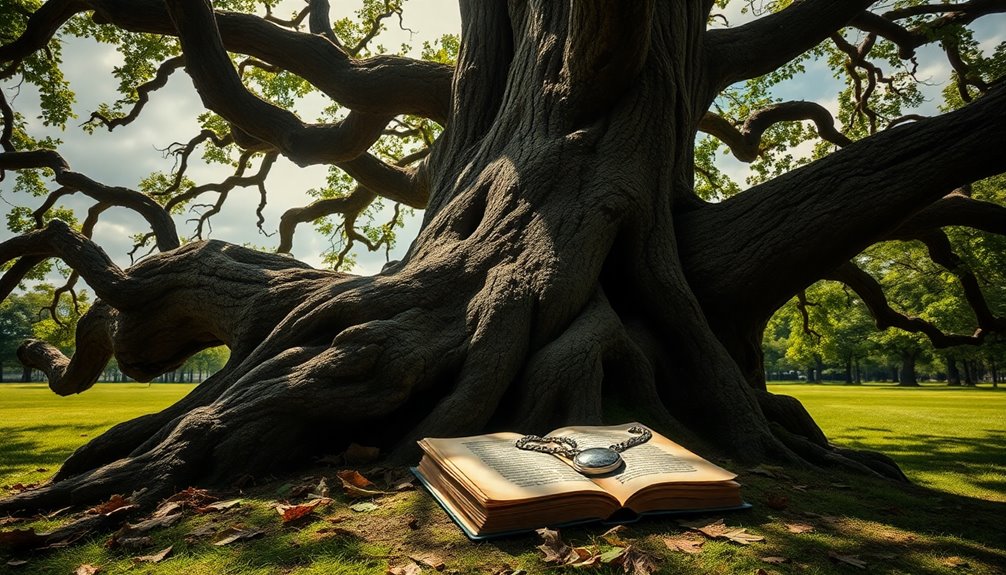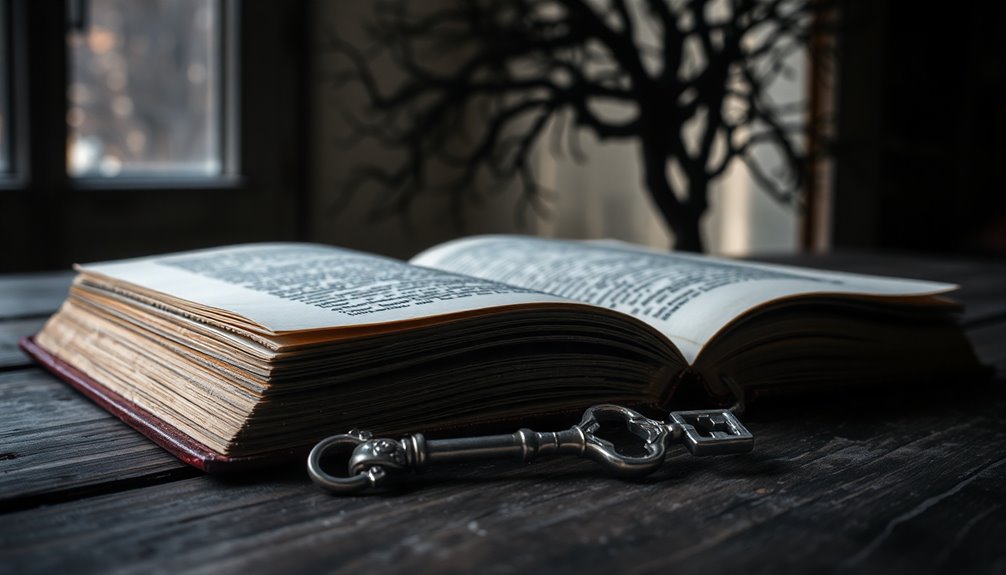Symbolism is an exciting tool in literature, helping you uncover deeper meanings and feelings hidden in stories. It uses images and objects to represent big ideas, making the reading experience richer and more engaging. For example, a green light might stand for hope or dreams, while a rainbow can represent happiness. These symbols let you connect emotionally with characters and themes, adding layers to the story without lengthy explanations. Plus, different readers might see different meanings in the same symbols! If you stick around, you'll discover even more ways symbolism brings stories to life!
Key Takeaways
- Symbolism reveals deeper meanings, enhancing readers' understanding of themes and emotions within the text.
- It creates emotional connections, allowing readers to relate more closely to characters and narratives.
- By using concrete images, symbolism conveys complex ideas succinctly without lengthy explanations.
- Recurring symbols establish thematic unity, reinforcing key messages throughout the plot.
- Contextual interpretation of symbols allows for diverse meanings, fostering exploration of universal themes in literature.
Definition of Symbolism

Symbolism is like a key that reveals deeper layers of meaning in literature. It's a special literary device that represents abstract ideas or concepts using concrete images, objects, or actions. This means that symbols can help you understand the story better!
For example, a dove might symbolize peace, while a storm could represent turmoil. These symbols carry different meanings, and their interpretations can change depending on the context of the story.
When you read, look for examples of symbolism to enhance your experience. A red rose might represent love, while winter could symbolize a difficult time in a character's life.
Understanding these symbols adds depth to the narrative and allows you to connect with the characters and themes on a more profound level.
Importance of Symbolism

Understanding the importance of symbolism in literature can greatly enhance your reading experience. When you immerse yourself in a story rich with symbolism, you discover layers of meaning that make the text come alive. Symbolism conveys themes and emotions through objects, actions, and characters, allowing you to grasp complex ideas without getting bogged down in tedious explanations.
As you read, you might find yourself feeling a stronger emotional connection to the characters and their journeys. This is because symbolism evokes emotional responses, prompting you to analyze the text more deeply. It helps create narrative depth, making the story more intriguing and engaging.
Additionally, symbolism promotes thematic unity throughout the plot. It ties together various elements of the story, ensuring everything resonates with broader societal issues and personal experiences. When writers use symbolism effectively, they create motifs that reinforce key themes, enhancing the overall emotional impact.
In short, by recognizing the importance of symbolism, you enrich your reading experience. You'll uncover deeper meanings and enjoy a more engaging journey through literature.
Symbolism in Classic Literature

When you think about classic literature, you'll find some really cool symbols that add depth to the stories.
For example, in *Lord of the Flies*, Piggy's glasses show how fragile our civilization can be, while the green light in *The Great Gatsby* represents dreams that seem just out of reach.
These symbols help us understand important themes like morality, society, and the human experience, making the stories even more interesting!
Classic Symbolism Examples
In classic literature, symbols often carry deep meanings that resonate with readers on multiple levels. These symbols can help us understand the characters and themes better. Let's explore some classic symbolism examples!
| Symbol | Meaning |
|---|---|
| Green Light | Gatsby's unattainable dreams and hopes |
| Red A | Adultery and resilience in *The Scarlet Letter* |
| Mockingbird | Innocence and goodness in *To Kill a Mockingbird* |
| Conch Shell | Law, order, and democracy in *Lord of the Flies* |
| White Whale | Obsession and the unknowable in *Moby Dick* |
Each of these symbols opens a door to deeper understanding. For instance, the green light in *The Great Gatsby* represents Gatsby's hopes, while the mockingbird symbolizes the need to protect the innocent. The red A in *The Scarlet Letter* reveals the complexities of sin, and the conch shell shows how fragile civilization can be. Ultimately, the white whale embodies obsession and vengeance. Classic symbolism enriches these stories, making them even more exciting to read! Furthermore, the use of symbolism in literature can reflect the greatest happiness principle, emphasizing the moral implications of characters' actions and their impact on overall well-being.
Symbolism's Thematic Significance
Classic literature uses symbolism not just for decoration but to enhance thematic exploration, allowing authors to convey complex ideas in nuanced ways. Think about how a simple object can carry so much meaning! For example, in *The Great Gatsby*, the green light symbolizes dreams that seem just out of reach. This creates a deeper analysis of hope and longing.
Symbols often serve as universal symbols, connecting with readers on many levels. In *Lord of the Flies*, Piggy's glasses represent not just hope but also the breakdown of society. It shows how fragile our world can be.
When you read *To Kill a Mockingbird*, consider the mockingbird as a symbol of innocence and goodness. It invites you to think about the importance of protecting those who are vulnerable.
These symbols add narrative complexity, making stories richer and more engaging. They create emotional resonance, prompting you to reflect on larger issues, like morality and social justice.
Symbolism in Poetry

Symbolism in poetry plays an essential role in conveying deep emotions and complex ideas with remarkable efficiency. When you read a poem, think about how symbols can create vivid images in your mind. For example, a rainbow might symbolize hope or happiness, as seen in Wordsworth's "My Heart Leaps Up." These symbols invite you to explore feelings and memories, making your reading experience richer.
In poetry, symbols often lack clear context, which means their meanings can vary widely. Your own perspective and cultural background shape how you interpret them. Poets use recurring symbols as motifs, helping to signal important themes throughout the poem. This creates a sense of unity and coherence, connecting different parts of the work.
As you immerse yourself in a poem, notice how the symbols add layers of meaning. For instance, the carriage in Emily Dickinson's "Because I Could Not Stop for Death" offers insights about life, death, and time.
Analyzing Symbols in Texts

When you immerse yourself in a literary text, recognizing symbols is essential for uncovering deeper meanings that enrich your understanding. Symbols can be objects, actions, or even characters that carry special significance. To really get the most out of a story, you should analyze these symbols closely.
Look for recurring motifs throughout the narrative. They can reveal important themes and provide insight into the author's message. Understanding the broader context is also vital. The meaning of a symbol can change depending on its surroundings, so pay attention to how it fits within the larger picture.
It's exciting to note that different interpretations of symbols can arise. This is often due to cultural backgrounds, personal experiences, and the narrative's context. Each reader may find unique meanings, adding layers to the text.
Engaging with literature through the lens of symbolism enhances your ability to uncover emotional depth and thematic unity across various plot elements.
Techniques for Using Symbolism

Creating powerful symbolism in your writing involves deliberate choices and a keen awareness of how symbols function within your narrative.
Symbolism is a powerful tool that can convey complex ideas and emotions. Here are some techniques to help you use symbolism effectively:
- Understand cultural context: Different cultures may interpret symbols in unique ways, so consider your audience.
- Use repeated symbols: Incorporating symbols throughout your story can create motifs, reinforcing themes and enhancing character development.
- Choose specific imagery: Select symbols that align with your narrative's themes, allowing for deeper meaning.
- Encourage multiple interpretations: Aim for symbols that can be understood in different ways. This invites readers to engage more deeply with your text.
- Explore complexities: Immerse yourself in the details of your symbols. This can lead to richer experiences and understanding for your readers.
Resources for Writers

If you want to sharpen your skills in using symbolism, there are plenty of fantastic resources out there for you!
Joining writing courses can give you expert feedback, while writers' groups let you share ideas and learn from others.
Plus, exploring writing prompts focused on symbols can make your stories even more exciting!
Courses for Writing Skills
Courses designed to enhance writing skills offer invaluable resources for aspiring authors. They teach you how to use symbolism in literature to create deeper meanings in your stories.
Whether you're just starting or looking to polish your craft, these courses can help you connect with readers and convey complex ideas effectively. Here are some exciting options:
- Visual Poetry Diary: Explore storytelling through visual imagery and symbolism.
- Writing a Novel Step by Step: Get structured exercises that boost creativity and help you weave symbolism into longer narratives.
- Storytelling Techniques: Learn how to engage readers emotionally using symbolism to deepen themes.
- Writing Exercises: Regular practice helps you develop skills in using symbols and motifs.
- Memoir Writing: Craft personal narratives that resonate universally, using symbolism to enrich your story.
These courses focus on creative writing and storytelling techniques, making your work of literature engaging and memorable.
Community Engagement Opportunities
Community engagement enriches the writing experience, making it easier for you to explore and refine your use of symbolism. By participating in a supportive writing community, you can share your work and receive valuable feedback. This interaction creates a lively space for collaborative learning and can help you understand the importance of low carb diets in maintaining focus during your writing sessions. Additionally, engaging in community discussions can enhance your understanding of key trends in writing techniques and literary symbolism. Engaging with others fosters curiosity and happiness, leading to a more fulfilling creative process.
Here are some community engagement opportunities to evaluate:
| Opportunity | Description | Benefits |
|---|---|---|
| Writing Prompts | Use prompts to spark creativity and practice symbolism. | Helps inspire fresh ideas! |
| Feedback Mechanisms | Engage in comments sections for instant feedback. | Get targeted feedback on your work. |
| Classes | Take classes focused on imagery and symbolism. | Learn techniques and improve skills. |
| Monthly Newsletters | Receive tips and resources on symbolism. | Stay updated and motivated! |
Additionally, engaging in community activities can help you align with high vibrational energy that enhances your creativity and writing skills.
Symbolism Exploration Resources
Exploring symbolism in your writing can be transformative, and various resources are available to help you dive deeper into this essential literary device. Understanding how authors use symbols in literature can enhance your storytelling skills.
Here are some fantastic exploration resources to contemplate:
- Writing Courses: Enroll in courses focused on imagery and symbolism to get targeted feedback. Platforms like Domestika offer great options.
- Writing Prompts: Engage with writing prompts that explore symbolism. This helps you integrate deeper meanings into your narratives.
- Workshops: Participate in community feedback mechanisms, such as writing workshops. Collaborating with others will sharpen your understanding of symbolism.
- Newsletters: Subscribe to newsletters that provide tips and resources on symbolism. Staying informed keeps your skills fresh and exciting.
- Books on Symbolism: Read books dedicated to understanding symbolism. They can offer insights into how to use these devices effectively.
Frequently Asked Questions
Why Is Symbolism Important in Literature?
Symbolism's super important in literature! It helps you find deeper meanings behind the words and ideas. When you spot a symbol, it makes the story more exciting and personal. You start to connect your own experiences with what you read.
Plus, symbols can tie different parts of the story together, making everything feel more unified. They also give writers a way to share important messages about society without saying them directly. Isn't that cool?
What Is the Purpose of Using Symbols?
The purpose of using symbols is to make stories richer and more exciting!
When you see an object or character that represents something deeper, it helps you connect to the story in a special way. Symbols can express big ideas, like friendship or bravery, without saying them outright.
They also create patterns that tie the story together, making it easier to feel emotions and understand the characters' journeys.
Isn't that awesome?
What Effect Does Symbolism Have on the Reader?
When it comes to symbolism, you're really opening a door to deeper meaning!
Symbols can grab your attention and make you think. They help you connect emotionally to the story, letting you explore ideas that are often bigger than the characters.
As you decode these symbols, you sharpen your critical thinking skills, too. It's like a treasure hunt for meaning, making your reading experience exciting and memorable!
You'll discover layers you never knew existed.
What Effect Does Symbolism Have on the Audience?
Symbolism can really spark your imagination! When you encounter a symbol, it adds depth to the story, making you think about its meaning.
It connects you to the characters and themes in a special way. You might feel strong emotions or see things differently.
Symbols can also reflect bigger ideas, showing how stories relate to the world around you.
Conclusion
In the world of literature, symbolism is like a hidden treasure waiting to be discovered! It adds depth and excitement to stories, making them come alive in your imagination. By using symbols, writers create connections that spark your curiosity and feelings. So, the next time you read, keep an eye out for these special signs—they might just change the way you see the story. Immerse yourself and enjoy the adventure of exploring the meanings behind the words!











